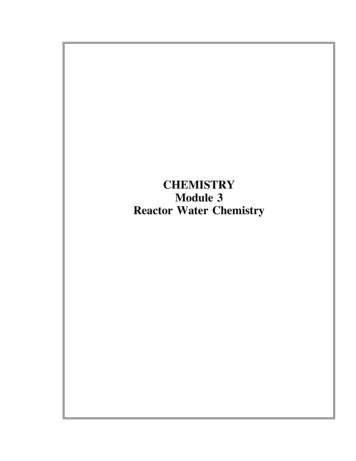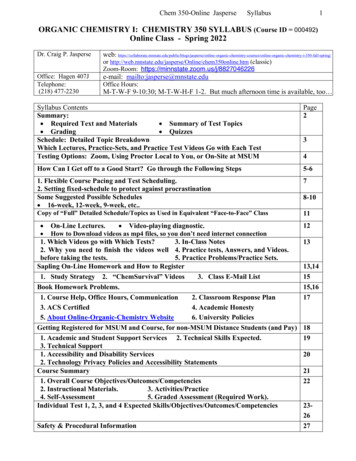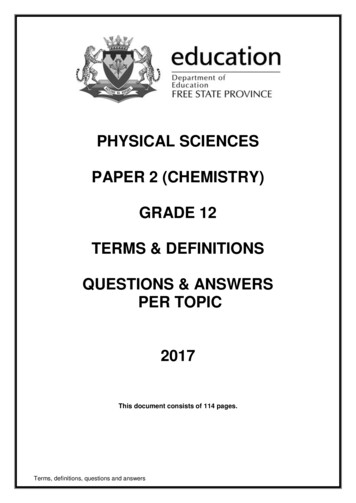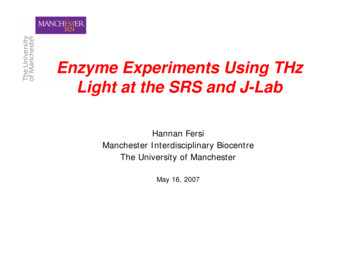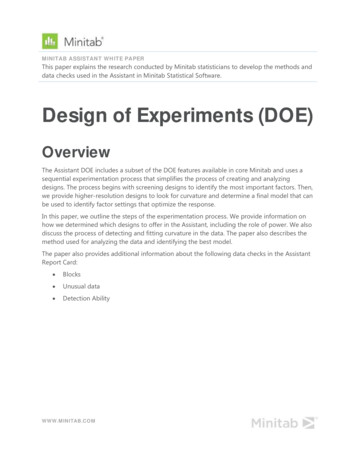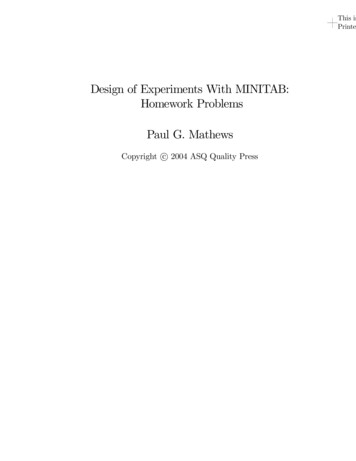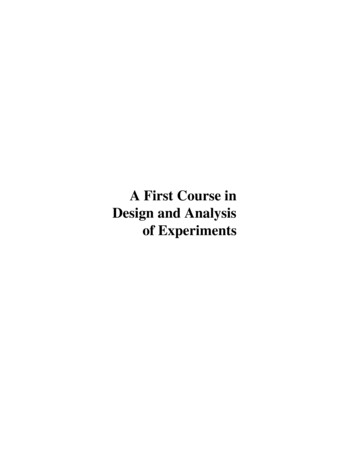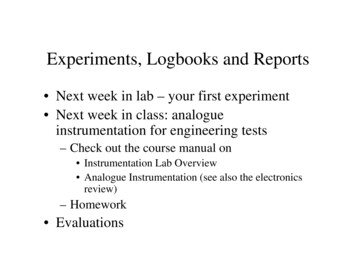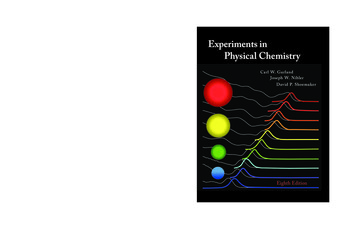
Transcription
EighthEditionEighth EditionThis comprehensive laboratory text includes 48 experiments with backgroundtheoretical information, complete experimental descriptions, safety recommendations,and computer applications. Updated chapters are provided regarding the collectionand analysis of data and the use of spreadsheets and other scientific software.Supplementary instructor information regarding necessary supplies, equipment, andprocedures is provided in an integrated manner in the text.Carl W. GarlandJoseph W. NiblerDavid P. ShoemakerMD DALIM 943693 1/15/08 CYAN MAG YELO BLACKThree of the experiments are completely new, and all make use of optical measurements. One involves a temperature study of the birefringence in a liquid crystalto determine the evolution of nematic order as one approaches the transition to anisotropic phase. The second uses dynamic laser light scattering from an aqueousdispersion of polystyrene spheres to determine the autocorrelation function thatcharacterizes the size of these particles. The third is a study of the absorption andfluorescence spectra of CdSe nanocrystals (quantum dots) and involves modeling ofthese in terms of simple quantum mechanical concepts.Experiments in Physical ChemistryExperiments in Physical ChemistryExperiments inPhysical ChemistryGarlandNiblerShoemakerEighth Edition
Rev. Confirming PagesEXPERIMENTS INPHYSICAL CHEMISTRYEIGHTH EDITION gar28420 fm i-x iCARL W. GARLANDJOSEPH W. NIBLERDAVID P. SHOEMAKERMassachusetts Institute of TechnologyOregon State University(deceased )Oregon State University1/25/08 9:41:39 PM
Rev. Confirming PagesEXPERIMENTS IN PHYSICAL CHEMISTRY, EIGHTH EDITIONPublished by McGraw-Hill, a business unit of The McGraw-Hill Companies, Inc., 1221 Avenueof the Americas, New York, NY 10020. Copyright 2009 by The McGraw-Hill Companies, Inc.All rights reserved. Previous editions 2003, 1996, 1989, 1981, 1974, 1967, 1962. No part of thispublication may be reproduced or distributed in any form or by any means, or stored in a databaseor retrieval system, without the prior written consent of The McGraw-Hill Companies, Inc.,including, but not limited to, in any network or other electronic storage or transmission, orbroadcast for distance learning.Some ancillaries, including electronic and print components, may not be available to customersoutside the United States.This book is printed on recycled, acid-free paper containing 10% postconsumer waste.1 2 3 4 5 6 7 8 9 0 QPD/QPD 0 9 8ISBN 978–0–07–282842–9MHID 0–07–282842–0Publisher: Thomas TimpSenior Sponsoring Editor: Tamara L. HodgeDirector of Development: Kristine TibbettsSenior Developmental Editor: Shirley R. OberbroecklingMarketing Manager: Todd L. TurnerSenior Project Manager: Kay J. BrimeyerSenior Production Supervisor: Kara KudronowiczAssociate Design Coordinator: Brenda A. RolwesCover Designer: Studio Montage, St. Louis, MissouriCompositor: Laserwords Private LimitedTypeface: 10/12 Times RomanPrinter: Quebecor World Dubuque, IACover description: The figure depicts the absorption and emission spectra of CdSe nanocrystals,whose color is a sensitive function of size. The figure is based on spectral data provided by NNLabs. The authors thank both NN-Labs and Evident Technologies for CdSe samples used in thedevelopment of the quantum dot experiment.Library of Congress Cataloging-in-Publication DataGarland, Carl W.Experiments in physical chemistry.—8th ed. / Carl W. Garland, Joseph W. Nibler, David P. Shoemaker.p. cm.Includes index.ISBN 978–0–07–282842–9—ISBN 0–07–282842–0 (hard copy : acid-free paper)1. Chemistry, Physical and theoretical—Laboratory manuals. I. Nibler, Joseph W.II. Shoemaker, David P. III. Title.QD457 .S56 2009541.078—dc222007043492www.mhhe.comgar28420 fm i-x ii1/25/08 10:53:13 PM
Confirming Pages ContentsPrefaceixI. INTRODUCTION1Organization of the BookPreparation for an ExperimentExecution of an ExperimentSafetyRecording of Experimental DataLiterature WorkReportsSample ReportSpecial ProjectsEthics24467910132627II. TREATMENT OF EXPERIMENTAL DATA29A. Calculations and Presentation of Data29Significant FiguresPrecision of CalculationsAnalytical MethodsNumerical MethodsGraphs and Graphical MethodsExercisesB. Uncertainties in Data and ResultsErrorsRejection of Discordant DataStatistical Treatment of Random ErrorsPropagation of ErrorsCase History of an Error EvaluationFundamental Limitations on Instrumental 16465 iiigar28420 fm i-x iii1/17/08 5:13:34 PM
Confirming PagesivContentsIII. USE OF COMPUTERSWord ProcessorsSpreadsheetsSymbolic Mathematics ProgramsQuantum Mechanical ProgramsInterfacing with ExperimentsExercisesIV. GASES1.2.3.Gas ThermometryJoule–Thomson EffectHeat-Capacity Ratios for GasesV. TRANSPORT PROPERTIES OF GASESKinetic Theory of Transport Phenomena4. Viscosity of Gases5. Diffusion of GasesVI. THERMOCHEMISTRYPrinciples of Calorimetry6. Heats of Combustion7. Strain Energy of the Cyclopropane Ring8. Heats of Ionic ReactionVII. SOLUTIONS9.10.11.12.Partial Molar VolumeCryoscopic Determination of Molar MassFreezing-Point Depression of Strong and Weak ElectrolytesChemical Equilibrium in SolutionVIII. PHASE BEHAVIOR13.14.15.16.Vapor Pressure of a Pure LiquidBinary Liquid–Vapor Phase DiagramOrdering in Nematic Liquid CrystalsLiquid–Vapor Coexistence Curve and the Critical PointIX. ELECTROCHEMISTRY17. Conductance of Solutions18. Temperature Dependence of emf19. Activity Coefficients from Cell MeasurementsX. CHEMICAL KINETICS20.21.22.23.24.gar28420 fm i-x ivMethod of Initial Rates: Iodine ClockNMR Study of a Reversible Hydrolysis ReactionEnzyme Kinetics: Inversion of SucroseKinetics of the Decomposition of Benzenediazonium IonGas-Phase 2542542632712832871/17/08 5:13:34 PM
Confirming PagesContentsXI. SURFACE PHENOMENA25. Surface Tension of Solutions26. Physical Adsorption of GasesXII. MACROMOLECULES27. Intrinsic Viscosity: Chain Linkage in Polyvinyl Alcohol28. Helix–Coil Transition in PolypeptidesXIII. ELECTRIC, MAGNETIC, AND OPTICAL PROPERTIES29.30.31.32.33.Dipole Moment of Polar Molecules in SolutionDipole Moment of HCl Molecules in the Gas PhaseMagnetic SusceptibilityNMR Determination of Paramagnetic SusceptibilityDynamic Light ScatteringXIV. sorption Spectrum of a Conjugated DyeRaman Spectroscopy: Vibrational Spectrum of CCl4Stimulated Raman Spectra of BenzeneVibrational–Rotational Spectra of HCl and DClVibrational–Rotational Spectra of AcetylenesAbsorption and Emission Spectra of I2Fluorescence Lifetime and Quenching in I2 VaporElectron Spin Resonance SpectroscopyNMR Determination of Keto–Enol Equilibrium ConstantsNMR Study of Gas-Phase DCl–HBr Isotopic Exchange ReactionSolid-State Lasers: Radiative Properties of Ruby CrystalsSpectroscopic Properties of CdSe NanocrystalsXV. SOLIDS46. Determination of Crystal Structure by X-Ray Diffraction47. Lattice Energy of Solid Argon48. Statistical Thermodynamics of Iodine SublimationXVI. ELECTRONIC DEVICES AND MEASUREMENTSCircuit ElementsOperational AmplifiersAnalog-to-Digital ConversionDigital MultimetersPotentiometer CircuitsWheatstone Bridge CircuitsXVII. TEMPERATURETemperature ScalesTriple-Point and Ice-Point CellThermometersTemperature Controlgar28420 fm i-x 75505525545575575615625761/17/08 5:13:34 PM
Confirming PagesviContentsXVIII. VACUUM TECHNIQUESIntroductionPumpsPressure GaugesSafety ConsiderationsXIX. oscopespH MetersPolarimetersRadiation CountersRecording Devices and PrintersRefractometersSignal-Averaging DevicesSpectroscopic ComponentsSpectroscopic InstrumentsTiming Devices601605605609611612613613617618631636XX. MISCELLANEOUS PROCEDURES639Volumetric ProceduresPurification MethodsGas-Handling ProceduresElectrodes for Electrochemical CellsMaterials for ConstructionSolders and AdhesivesTubing ConnectionsShopworkXXI. LEAST-SQUARES FITTING PROCEDURESIntroductionFoundations of Least SquaresWeightsRejection of Discordant DataGoodness of FitComparison of ModelsUncertainties in the ParametersSummary of ProceduresSample Least-Squares Calculationgar28420 fm i-x 6786806811/17/08 5:13:35 PM
Confirming 3701707709718719Glossary of SymbolsInternational System of Units and Concentration UnitsSafetyLiterature WorkResearch JournalsNumerical Methods of AnalysisBarometer CorrectionsEthical Conduct in Physical ChemistryIndexEndpapersPhysical Constants and Conversion FactorsEnergy Conversion TableRelative Atomic Masses of the Elementsgar28420 fm i-x viivii721FrontFrontBack1/17/08 5:13:35 PM
Confirming PagesI often say that when you can measure what you are speaking about, and expressit in numbers, you know something about it; but when you cannot express it innumbers, your knowledge is of a meagre and unsatisfactory kind; it may be thebeginning of knowledge, but you have scarcely, in your thoughts, advanced to thestage of Science, whatever the matter may be.Sir William Thomson(Lord Kelvin)It is much easier to make measurements than to know exactly what you aremeasuring.J. W. N. SullivanIt is a capital mistake to theorize before one has data. Insensibly one begins to twistfacts to suit theories, instead of theories to suit facts.Sir Arthur Conan DoyleIt is also a good rule not to put too much confidence in experimental results untilthey have been confirmed by theory.Sir Arthur Eddingtonviiigar28420 fm i-x viii1/17/08 5:13:35 PM
Confirming Pages PrefaceThis book is designed for use in a junior-level laboratory course in physical chemistry. Itis assumed that the student will be taking concurrently (or has taken previously) a lecturecourse in physical chemistry. The book contains 48 selected experiments, which have beentested by extensive use.Three of the experiments are new, and all of these involve optical measurements.One concerns a study of the birefringence of a liquid crystal to determine the evolution ofnematic order near the nematic-isotropic phase transition (Exp. 15). The second is a studyof the dynamic light scattering from an aqueous dispersion of polystyrene spheres in orderto determine their particle size (Exp. 33). The third is a study of the absorption and fluorescence spectra of CdSe nanocrystals with an analysis based on predictions from a quantummodel (Exp. 45). To conserve space, three experiments that appeared in the seventh editionhave been deleted. These are the binary solid-liquid phase diagram, osmotic pressure, andsingle-crystal x-ray diffraction. All the other experiments from the seventh edition havebeen reviewed, and in some cases small changes have been made to either the theory orthe experimental procedures. The most extensive of such changes occur in Experiments 1 (gasthermometry) and 4 (viscosity of gases), where the apparatus and procedure have beenchanged to eliminate the use of mercury. In numerous other experiments, mercury manometers and mercury-in-glass thermometers have been replaced by direct reading pressuregauges and temperature sensors.Experiments. The 48 experiments provide a balance between traditional and modern topics in physical chemistry, with most of the classical topics in Chapters IV–X (Exps.1–24) and most of the modern topics in Chapters XI–XV (Exps. 25–48). These experiments are not concerned primarily with “techniques” per se or with the analytical applications of physical chemistry. We believe that an experimental physical chemistry courseshould serve a dual purpose: (1) to illustrate and test theoretical principles, and (2) todevelop a research orientation by providing basic experience with physical measurementsthat yield quantitative results of important chemical interest.Each experiment is accompanied by a theoretical development in sufficient detailto provide a clear understanding of the method to be used, the calculations required, andthe significance of the final results. The depth of coverage is frequently greater than thatwhich is available in introductory physical chemistry textbooks. Experimental proceduresare described in considerable detail as an aid to the efficient use of laboratory time and ixgar28420 fm i-x ix1/17/08 5:13:35 PM
Confirming PagesxPrefaceteaching staff. Emphasis is given to the reasons behind the design and procedure for eachexperiment, so that the student can learn the general principles of a variety of experimentaltechniques. Stimulation of individual resourcefulness through the use of special projects orvariations on existing experiments is also desirable. We strongly urge that on some occasions the experiments presented here should be used as points of departure for work of amore independent nature.Introductory and background material. In addition to the experiments themselves, nine chapters contain material of a general nature. These chapters should be usefulnot only in an undergraduate laboratory course but also in special-project work, thesisresearch, and a broad range of general research in chemistry.The first three chapters provide material that is valuable for all experimental workin physical chemistry, and it is recommended that these be read before beginning anylaboratory work. Chapter I contains a wide range of introductory material, includingadvice on the preparation of laboratory reports, and Chapter II covers techniques for dataanalysis and the assessment of error limits. Chapter III, on the use of computer softwareand selected aspects of computer interfacing, has been revised and updated. The softwareaspect emphasizes the application of spreadsheets for the recording, plotting, and leastsquares fitting of experimental data. Also discussed, and illustrated with examples, aremore sophisticated programs such as Mathcad and Mathematica, along with the programGaussian, which can be used to obtain molecular structures and properties from ab-initioquantum mechanics. Relevant theoretical calculations using such programs are suggestedat the end of a number of experiments.Chapters XVI–XX deal with basic experimental methods of broad value in manytypes of experimental work—electronic measurements, temperature measurement andcontrol, vacuum techniques, diverse instruments that are widely used, and miscellaneouslaboratory procedures. These chapters have been revised and updated in various ways.In the case of Chapters XVI and XVIII, the text has also been shortened from that whichappeared in the seventh edition. Finally, Chapter XXI presents a thorough discussion ofleast-squares fitting procedures.References cited at the end of each experiment and each of the general chaptershave been updated. In cases where no new literature source could be found that covers agiven topic as well as the source cited in the seventh edition, the original citation has beenretained, since most libraries have available copies of older books and monographs.In the development of the new experiments in this edition, we acknowledge expertadvice from Prof. M. Bawendi (MIT), Prof. J. Thoen (Katholieke Universiteit Leuven),and Dr. B. Weiner (Brookhaven Instruments) as well as the assistance of faculty, teachingassistants, and undergraduate students (especially Nicole Baker, Matthew Martin, ColinShear, Brain Theobald, and Robert Zaworski) at Oregon State University. Helpful comments also have come from a number of reviewers and from those who have used thisbook at other universities, and for these we are very appreciative. We encourage and welcome feedback from all who use this book, either as students or instructors.Finally, we wish to acknowledge the suberb proofreading effort of Janelle Pregler,who has made the production of this edition go very smoothly.Carl W. GarlandJoseph W. Niblergar28420 fm i-x x1/17/08 5:13:35 PM
Confirming PagesIIntroductionPhysical chemistry deals with the physical principles underlying the properties of chemicalsubstances. Like other branches of physical science, it contains a body of theory that hasstood the test of experiment and is continually growing as a result of new experiments. Inorder to learn physical chemistry, you must become familiar with the experimental foundations on which the theoretical principles are based. Indeed, in many cases, the ability toapply the principles usefully requires an intimate knowledge of those methods and practical arts that are called “experimental technique.”For this reason, lecture courses in physical chemistry are usually accompanied by aprogram of laboratory work. Such experimental work should not just demonstrate established principles but should also develop research aptitudes by providing experience withthe kind of measurements that can yield important new results. This book attempts toachieve that goal. Its aim is to provide a clear understanding of the principles of importantexperimental methods, the design of basic apparatus, the planning of experimental procedures, and the significance of the final results. In short, the aim is to help you become aproductive research scientist.Severe limitations of time and equipment must be faced in presenting a set of experiments as the basis of a laboratory course that will provide a reasonably broad coverageof the wide and varied field of physical chemistry. Although high-precision researchmeasurements would require refinements in the methods described here and would oftenrequire more sophisticated and more elaborate equipment, each experiment in this book isdesigned so that meaningful results of reasonable accuracy can be obtained.In the beginning, you will probably not have the skill and the time to plan detailedexperimental procedures. Moreover, the trial-and-error method is not necessarily the bestway to learn good experimental technique. Laboratory skills are developed slowly duringa sort of apprenticeship. To enable you to make efficient use of available time, both theapparatus and the procedure for these experiments are described in considerable detail.You should keep in mind the importance of understanding why the experiment is done inthe way described. This understanding is a vital part of the experience necessary for planning special or advanced experiments of a research character. As you become more experienced, it is desirable that there be opportunities to plan more of your own procedure. Thiscan easily be accomplished by introducing variations in the experiments described here. Achange in the chemical system to be studied, the use of equipment that purposefully differs from that described, or the choice of a different method for studying the same system1gar28420 ch01 001-028.indd 111/22/07 9:16:07 AM
Confirming Pages2Chapter IIntroductionwill require modifications of the procedure. Finally, at the end of the course, it is recommended that, if possible, you carry out a special project that is completely independent ofthe experiments described in this book. A brief description of such special projects is givenat the end of this chapter.In addition to a general knowledge of laboratory techniques, creative research workrequires the ability to apply two different kinds of theory. Many an experimental methodis based on a special phenomenological theory of its own; this must be well understoodin order to design the experiment properly and in order to calculate the desired physical property from the observed raw data. Once the desired result has been obtained, itis necessary to understand its significance and its interrelationship with other knownfacts. This requires a sound knowledge of the fundamental theories of physical chemistry(e.g., thermodynamics, statistical mechanics, quantum mechanics, and kinetics). Considerable emphasis has been placed on both kinds of theory in this book.In the final analysis, however, research ability cannot be learned merely by performing experiments described in a textbook; it has to be acquired through contact with inspiredteachers and through the accumulation of considerable experience. The goal of this book isto provide a solid frame of reference for future growth. ORGANIZATION OF THE BOOKBefore undertaking any experiments, you should become familiar with the overallstructure of this book. The material is divided into three blocks: essential introductorymaterial is given in Chapters I–III, the experiments are given in Chapters IV–XV, andextensive reference material is given in Chapters XVI–XXI. The heart of the book is thecollection of experiments, which are designed to provide significant “hands-on” laboratoryexperience. The general chapters present basic background information of value both forundergraduate laboratory courses and for independent research work.INTRODUCTORY ESSENTIALSChapter I provides a general introduction to experimental work in physical chemistry.This includes advice on how to prepare for and carry out an experiment, how to recorddata in a laboratory notebook, and how to report results. Chapter II describes mathematical procedures for analyzing data. Part A of this chapter deals with calculations and thepresentation of numerical results, and Part B is concerned with the quantitative assessmentof random errors and their effect on the uncertainty in the final result. Chapter III dealswith several types of computer hardware and software commonly used in physical chemistry. Commercial products for digital measurement of temperature, voltage, and pressureare now readily available, and the need for machine-level programming has been greatlyreduced. Examples of some data collection systems are briefly described. Emphasis isplaced on the use of spreadsheets, since these are very convenient for data handling, analysis, and presentation in both tabular and graphic forms. All three chapters should be readat the very beginning, since they provide general information of value for all experimentsin physical chemistry.It is important to mention briefly the issues of notation and units. A glossary of frequently used symbols is given in Appendix A. Note that the definition of thermodynamicwork used here is the work done on a system (e.g., dw p dV). As a result, the first lawof thermodynamics has the form dE dq dw. Note also that E is used for the thermodynamic internal energy and U for the potential energy instead of the IUPAC choices ofgar28420 ch01 001-028.indd 211/22/07 9:16:08 AM
Confirming PagesOrganization of the Book3U and V respectively. Système International (SI) units, described in Appendix B, are usedextensively but not slavishly. Chemically convenient quantities such as the gram (g), cubiccentimeter (cm3), and liter (L dm3 103 cm3) are still used where useful—densities ing cm 3, concentrations in mol L 1, molar masses in g. Conversions of such quantities intotheir SI equivalents is trivially easy. The situation with pressure is not so simple, since theSI pascal is a very awkward unit. Throughout the text, both bar and atmosphere are used.Generally bar ( 105 Pa) is used when a precisely measured pressure is involved, andatmosphere ( 760 Torr 1.01325 105 Pa) is used to describe casually the ambient airpressure, which is usually closer to 1 atm than to 1 bar. Standard states for all chemicalsubstances are officially defined at a pressure of 1 bar; normal boiling points for liquidsare still understood to refer to 1-atm values. The conversion factors given inside the frontcover will help in coping with non-SI pressures.EXPERIMENTSChapters IV–XV contain the descriptions of the experiments, which are numbered1 to 48. In addition, Chapters V and VI each contain some separate introductory materialthat is pertinent to all the experiments in the given chapter. Each figure, equation, and tablein a given experiment is identified by a single number: e.g., Fig. 1, Eq. (8), Table 2. Forcross references, double numbering is used: e.g., Fig. 38-1 refers to Fig. 1 in Exp. 38 andEq. (V-8) refers to Eq. (8) in the introductory part of Chapter V.Every attempt has been made to write each experiment in sufficient detail that it canbe intelligently performed without the necessity of extensive outside reading. However,it is assumed that the student will refer frequently to a standard textbook in physicalchemistry for any necessary review of elementary theory. Literature sources are citedexplicitly for those topics that are beyond the scope of a typical undergraduate textbook, and these numbered references are listed together at the end of each experiment.In addition, a selected list of reading pertinent to the general topic of each experiment isgiven under the heading General Reading. It is hoped that you will do some reading inthese books and journal articles, since this is an excellent way to broaden your scientificbackground.A complete and very detailed list of equipment and chemicals is given at the end ofeach experiment.1 The list is divided into two sections: Those items listed in the first paragraph are required for the exclusive use of a single team; those in the second paragraph areavailable for the common use of several teams. It is assumed that standardized stock solutions will be made up in advance and will be available for the students’ use. The quantitiesindicated in parentheses† are for the use of the instructor and do not indicate the amountsof each chemical to be taken by a single team. In addition to the items included in theseapparatus lists, it is assumed that the laboratory is equipped with analytical balances, asupply of distilled or deionized water, and a barometer as well as gas, water, and 110-Vac power lines. Also desirable, but not absolutely necessary, are gas-handling lines and arough vacuum line.BASIC REFERENCE MATERIALChapters XVI–XX contain a variety of information on experimental procedures anddevices. This includes the theory and practice of many types of electrical measurements,†On the basis of the authors’ experience, it is necessary to make available these amounts for each team that willdo the experiment. They are scaled up from the amounts stated in the experiment to provide for possible wastageand to give a generous safety factor. It is hoped that they will be useful as a rough guide the first time an experiment is given.gar28420 ch01 001-028.indd Sec1:311/22/07 9:16:08 AM
Confirming Pages4Chapter IIntroductionthe principles and devices used in measurement and control of temperature, vacuum techniques, detailed descriptions of frequently used instruments, and a description of manymiscellaneous procedures such as gas handling and the construction of equipment.Chapter XXI provides an introduction to least-squares fitting procedures and a discussion of how to assess the magnitude of random errors and how to judge the quality ofany given fit to a set of data points. PREPARATION FOR AN EXPERIMENTAlthough most of the experiments in this book can be performed by a single person,they have been written under the assumption that a pair of students will work togetheras a team. Such teamwork is advantageous, since it provides an opportunity for valuablediscussion of the experiment between partners. The amount of experimental work to beassigned will be based on the amount of laboratory time available for each experiment.Many of the experiments can be completed in full during a single 4-hour laboratory period.Many others are designed for 6 to 8 hours of laboratory work but may be abridged sothat meaningful results can be obtained in a single 4-hour period. Some of the experiments require at least 6 hours and should not be attempted in a shorter time (in particular,Exps. 22, 24, 26, 28).Before you arrive in the laboratory to perform a given experiment, it is essential thatyou study the experiment carefully, with special emphasis on the method, the apparatusdesign, and the procedure. It will usually be necessary to make changes in the procedurewhenever the apparatus to be used or the system to be studied differs from that describedin this book. Planning such changes or even successfully carrying out the experiment asdescribed requires a clear understanding of the experimental method.Experimental work in physical chemistry requires many complex and expensivepieces of apparatus; many of these have been constructed specially and cannot readilybe replaced. Each team should accept responsibility for its equipment and should check itover carefully before starting an experiment. EXECUTION OF AN EXPERIMENTMaking experimental measurements is like playing the piano or singing a song. Youneed some natural ability—bright students with no innate experimental skills often endup as theorists—but most people can learn to execute an experiment and have a lot of fundoing it. Like playing the piano and singing, you get better with practice. It is also usefulto start with something reasonably simple and build up experience with a variety of techniques before taking on a really tough experiment.GENERAL ADVICESome of the practice involved in developing experimental skills occurs within a single experiment and some occurs as the superposition of many experiments. In carrying outany given experiment, it may be necessary to make several “runs”, i.e., sets of measurements. On some occasions, it is worthwhile to carry out a practice run as a warmup test ofthe apparatus and your own skills. Such a practice run can be made with a known standardmaterial or standard set of conditions, or it can be a first try at a real set of measurementsto get a feel for the operation of the equipment.gar28420 ch01 001-028.indd Sec1:411/22/07 9:16:09 AM
Confirming PagesExecution of an Experiment5The design of the experiment will require a decision about the number of data pointsto be taken in each run and the number of runs needed; see the next subsection o
ern topics in physical chemistry, with most of the classical topics in Chapters IV–X ( Exps. 1–24) and most of the modern topics in Chapters XI–XV (Exps. 25–48). These experi-ments are not concerned primarily with “tec

